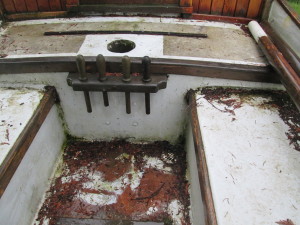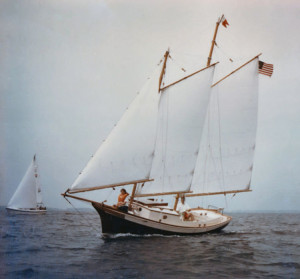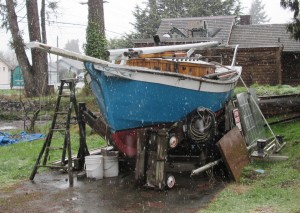A boat by the side of the road invites inquiry. Driving by without hearing their stories seems an act of neglect. I don’t mean the sort of boat that’s sitting behind a car on a trailer with a flat tire. I mean the sort that squats in someone’s yard looking like it has grown roots, a boat that should be carving a carefree wake in the washboard surface of a wave tossed sea. It sits there among the trees whose solidity it mimics without so much as creating a furrow in the leaf-littered lawn. You see them everywhere but most are not worth a second glance.
Every so often one of these dry land dreams catches my eye with a stronger light. They radiate the kind of vibration I used to get when I was an antiques dealer in search of valuable merchandise. For me, character born of craftsmanship and tradition has a palpable effect on the senses I have never been able to explain. It heralds a recognition of quality, that an item is well made and possesses a quality of design that is enduring and intrinsically valuable. The finest kind of-of these nautical discoveries is the sight of a schooner. The problem with Schooners is they are usually so big, so inaccessible, and unattainable. Schooner rigs work best on a heavy displacement cargo hauling, people-moving vessel. It’s a rare thing to come upon an example of the type on a scale that a working man can relate to.
When I first came to the Pacific Northwest I did a lot of rambling around the Olympic Peninsula. My eyes were always peeled for interesting boats. Carlsborg, Washington is a sprinkling of houses and businesses along a road by the same name. While driving that road one day I spotted a blue hull under a tarp setting back from the road. A subtle jangling of an old familiar vibe rattled in my head. A set of davits protruded from the stern and a bowsprit pointed the way forward. She was clearly a traditional type of sailing vessel so I played the usual game in my head of guessing the rig type, make, model, and designer. My mental database kept coming up with a connection between this boat and the location. I remembered a boatbuilder from Carlsborg because I had ordered study plans from him for a design advertised in the long gone Small Boat Journal magazine back in the early eighties. This boat didn’t quite match the memory of the 22-foot cutter called the “Dungeness Crabber” by her designer but something spoke to me and remained in memory.
I passed by this mystery boat many times over the past 11 years. She never appeared to go anywhere. The boat was waiting for something to happen.
On one of my weekly drives through the Port Angeles Boat Haven, I stopped to check out the bulletin board. A full-color advertisement showed a picture of a familiar looking blue hull. There she was like an old friend discovered on Facebook. Better yet, the ad answered questions that had buzzed around in my brain for years. The heading said, ” Sailboat For Sale, 23′ John Atkins Gaff Rigged Schooner ‘Florence Oakland'” A number of pieces fell into place immediately.
I have admired this design for years. One of the few very small schooner designs with a proven reputation, she measures 22’ 5″ long on deck and carries 297 square feet of sail in a well-balanced set of main, fore and jib. She was built with an extended cabin and self-bailing cockpit making her one of the saltiest looking pocket yachts I have ever come across. This boat sits with no name on her transom. In fact, she was never launched and was in need of some finishing touches. I had to know more about this little schooner because this boat comes complete with an interesting history.
John Magner was a boatbuilder with an eye for tradition. He built boats that were uncomplicated, salty and sound including  William Short’s Great Pelicans, several of John Atkins designs including two schooners and various dinghies and daysailers. On a snowy day in February, I drove to Carlsborg to meet with John’s sons and take a closer look at the boat. The builder began construction in the 1970s. He worked on her intermittently between other building projects. Mr. Magner passed away in 1989 after battling cancer. This left the boat unfinished and she remained in that state ever since. The hull is built from wedge seamed Alaska Yellow Cedar below the waterline and red Cedar above. The cabin and cockpit are basically complete. The interior needs some finish work and an old Volvo Penta is installed on solid engine beds but needs work and various things hooked up. There are tanks which were never fully installed. The masts and spars are finished and look to be in good condition. Some bits and pieces of rigging are present but for the most part, she needs some more standing rigging and a complete compliment of running rigging. There are no sails. Sanding and repainting are necessary. There is some rot around the corner post on the starboard forward cabin top. I was shown a blistered section of the plywood coaming on the starboard side. The boat has been tarped over all these years but did suffer these few effects from exposure.

Bridge deck at the forward end of the cockpit has a hole for the mainmast and a nice rack of belaying pins.
This boat was built from a John Atkin design. Florence Oakland was designed for Jacob Hess of Canton Ohio. It was named after his mother-in-law. It was originally designed for plywood construction to make the boat trailerable. Several versions of the design have been adapted for batten seam construction so it is not surprising that Mr. Magner opted for wedged seams.
The sail plan spreads out a lot of sail area in a low aspect ratio that promises a good degree of stability. She would handle easily getting off a mooring with just the big mainsail raised. Atkin’s original concept was for a daysailer with a lot of cockpit space and a small cuddy cabin forward. This boat has an extended cabin going back to the main mast. While not creating spacious accommodations it provides a cozy situation for weekends and longer vacation voyaging. A simple galley arrangement will allow for basic boat camping meals and a whistling teapot dispensing hot drinks and charming ambiance.
More can be learned about this interesting design at the Atkin & Sons website. I recommend an article “Florence Oakland, A Backyard Schooner” by Mike O’Brien originally published in Boat Design Quarterly also found at the Atkin & Sons website. John Magner’s sons would like to see their father’s work go to an owner who will appreciate the work that has already gone into this charming little schooner. They are asking $5,000. This is a fraction of the current cost in materials and time. She would make a fine project for any builder with a heart for tradition and an urge to feel the pull of a schooner’s tiller in their hand. You can contact Kevin Magner at 360-683-5653 or email at reveriegardens@olypen.com





